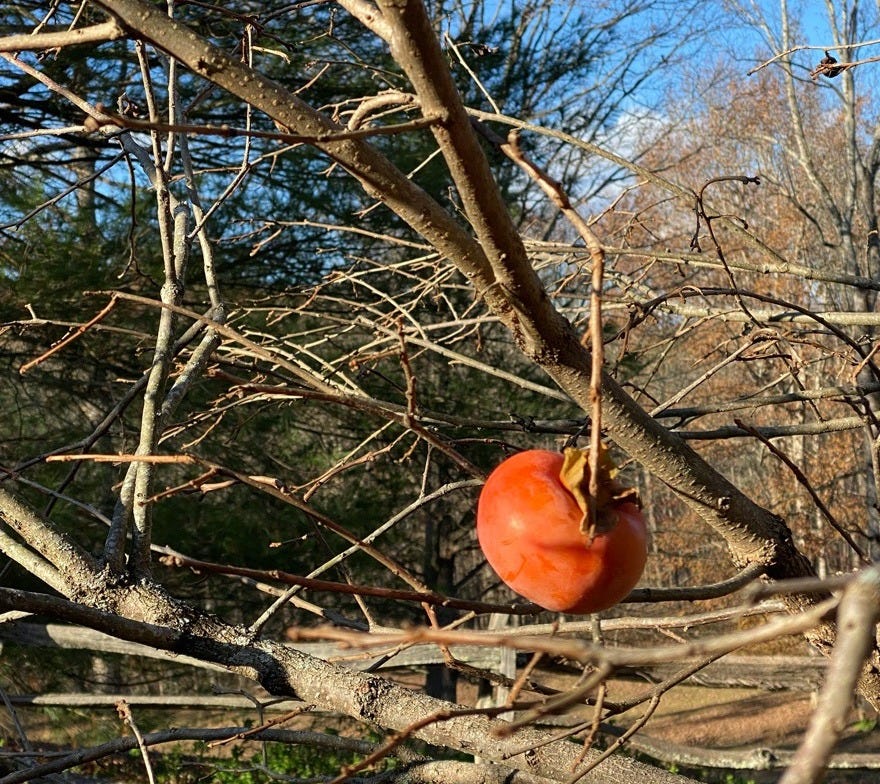Thanksgiving is over, thank goodness. Everything was perfect: the fair weather, the friendly crowd, the groaning table, the children wanting to 1) play hide and seek, 2) climb trees, 3) hit badminton birdies, 4) throw balls for the dogs, 5) chase the chickens, 6) torment the cats, and 7) feed carrots to the horses, all in quick and repeating rounds. While I ferried hot pans of baked beans, mac & cheese, and brussels sprouts to the table, they trailed behind me asking if there were ice cream treats in the freezer for them—no?—then how about popsicles?—while their elders broke into laughter around mounds of appetizers in the next room.
I love remembering these things more than living through them. It’s the moments after I live for: the sudden quiet when the last guest has gone, the stack of dishes with the fingerprints of my nearest and dearest on them, though thankfully the dishes cannot talk back. When I leave the clean kitchen for the yard on Friday morning, I drift from the mostly-empty bird feeders to the mostly-withered garden to the mostly-quenched firepit, where it is still possible to feel a touch of warmth from last night’s fire on the flats of my hands.
There’s a saying about how much better it is to live from a sense of abundance than a sense of scarcity. That makes great sense in most contexts, but on the morning after Thanksgiving, it’s the rareness of things that brings me close to tears. I’m sure it’s because I’ve always had enough of everything necessary for life with some left over, though only in the realm of things that humans can make happen. Outside in the late November weather, a different kind of power is underway.
If you’ve ever seen a gingko tree at its peak in autumn, you know there’s not another yellow like it. Mine came from a female gingko in my mother’s yard, which means that her tree dropped dozens of fleshy, smelly pods each year. In her eighties, she started picking them up, putting them in big clay pots, and watering them with a garden hose made in the last millennium. When she died, my two sisters and I each chose a seedling from her knee-high forest to take home with us.
Mine is about twenty feet tall now. For a couple of weeks each fall, it is so dazzling that it seems to give off its own light. I never get used to it. It surprises me every morning. Then one morning—usually right on the heels of the first frost—the tree drops all of its leaves at once. No big wind makes this happen. The tree decides. One day it’s full, and the next day it’s empty. The one gives meaning to the other.
There’s a persimmon tree next to the gingko, with emerald leaves and green fruit that turns flame-colored in fall. If you can get both of these trees in your viewfinder at the right time, they look like something embroidered in the Middle Ages. We sliced a few of the persimmons on Thanksgiving afternoon, trying to make the children’s mouths pucker, but they opted for the banana pudding instead.
On the quiet morning after, still out in the yard, I find a perfect circle of yellow leaves under the gingko tree, as if a ballerina has shed her long skirt overnight. There is one last persimmon on the tree next to it, bending its thin branch toward the earth. This scant beauty opens the floodgate of my gratitude so wide that I can’t find the line between abundance and scarcity right now. All I can find is thanks.





Persimmons will always remind me of my mother (still living) who would describe them to me in Japanese and how she loved them. We cherished and savoured every bite…
Love the description of the graceful gingko leaves.